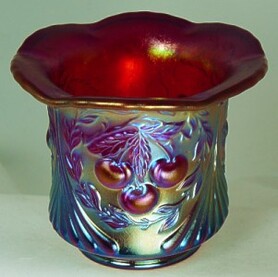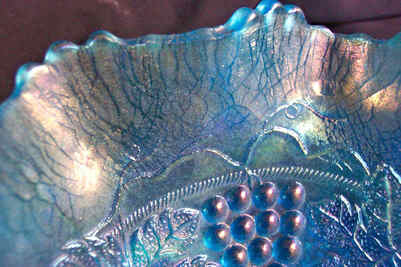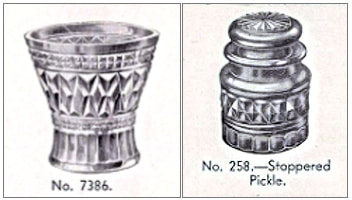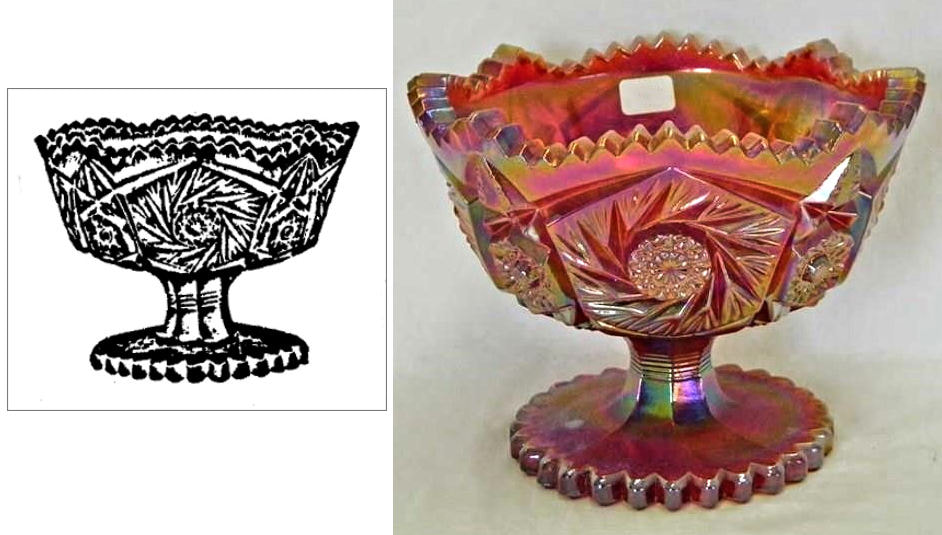NetworK ezine Issue 102. November 2023
Totally Devoted to Carnival Glass
|
The Magic of Iridescence
Welcome to the 102nd issue of our Carnival Glass NetworK ezine, in which we take a revealing look at iridescence, and discover some of its secrets. Iridescence is both stunning and mysterious, often beguiling us and causing us to stop and ponder. A glance at the pieces in the group on the right tells a story. The tall Rustic Variant vase at the back looks similar in colour to the handled bonbon in the foreground. They both look green. The Ripple vase in the middle looks the same kind of colour as the little Millersburg Peacock bowl on the right - they both appear bronzey amber. The small Amaryllis compote on the left looks different to the others, in fact the stem and foot look black. So what colours are they really? The Fenton Rustic Midsize Variant at the back is green. The Imperial Ripple in the middle is amber. The Millersburg Peacock bowl on the right is actually amethyst with a bronzey iridescence. The Northwood Basket of Roses handled bonbon at the front that looks green is, in fact, purple base glass with a green iridescence. The little Dugan Amaryllis compote on the left is deep, dark purple with a vivid, multi-coloured iridescence. What you’re looking at is the magic of iridescence - the ability to alter the appearance of the glass through a combination of the way the light is reflected and the angle of view. Twist and turn the glass and the iridescence changes as the light alters. It’s not easy to define or explain iridescence to someone who is not familiar with it. Once you have seen it, you understand, but without that, many of us fall back on referring to “oil-on-water,” soap bubble and rainbow effects. The most fundamental characteristic of Carnival Glass is that it must be iridescent (as well as being moulded and usually with a moulded pattern). So, let’s take a look at some of the intriguing facts of iridescence. The How, What, Why and When behind that most vital feature Carnival Glass. |
HOW - How is Carnival Glass iridised?
Carnival Glass is iridised by the application of metallic salts in liquid form (often called "dope"), on to hot glass. The process that is primarily used for Carnival is to press the molten glass into a mould, remove and shape it if/as required, and then reheat the item. The final stage is to immediately spray the metallic salts onto the hot glass, usually in some kind of chamber. As the glass is very hot at this point, the metallic salts adhere and combine to produce the iridescent effect. After iridising, the still hot glass is placed in a lehr to slowly cool (anneal).
Carnival Glass is iridised by the application of metallic salts in liquid form (often called "dope"), on to hot glass. The process that is primarily used for Carnival is to press the molten glass into a mould, remove and shape it if/as required, and then reheat the item. The final stage is to immediately spray the metallic salts onto the hot glass, usually in some kind of chamber. As the glass is very hot at this point, the metallic salts adhere and combine to produce the iridescent effect. After iridising, the still hot glass is placed in a lehr to slowly cool (anneal).
|
Spraying the iridising “dope” onto the hot glass at Fenton, c. 2000.
The hot glass plate is held in the “snaps” and turned, while the operator sprays the metallic solution. Courtesy the late Howard Seufer. |
Another way of iridising glass that was primarily used for earlier Art Glass, is to add the metallic substances, such as silver or bismuth, to the glass batch and then reheat it to coax out the iridescent effects. This is how Fenton’s Favrene was made in recent years. A Flowers of the World bowl in Favrene* by Fenton.
The pattern was designed by Glen Thistlewood |
* Technically, Favrene was very difficult to make; the glass batch contained real silver, and required a special reheating process to coax the silvery layer to the surface of the glass. But the result is spectacular.
WHAT – What are those metallic salts?
Various metallic salts could be used to create iridescence on glass. When most people think of Carnival, they tend to visualise marigold which was created by ferric (iron) chloride. It gave the rich golden orange tones to clear glass, changing it from something plain, to something exotic and beautiful. It was also reminiscent of the golden iridescent shades on much early Bohemian iridescent glass, as well as the British Webb’s and Stevens & Williams’ and of course, the
|
golden versions of Tiffany’s Favrene and Steuben’s Aurene.
Thomas Webb’s iridised glass (dating from 1878 on) was collectively known as “Aurora”, while their “marigold” was called “Iris”. Some of the early names used for this “marigold” iridescence were subsequently adopted by Classic Carnival makers and their agents. Shown below is a "buyer’s note" extract from the 1910 “Pottery, Glass & Brass Salesman”. Dugan’s Carnival was described as “Aurora Iris ware”, channelling the widely-used, earlier terms for Webb’s iridescent glass.
|
Above: an 1884 ad for Webb’s iridescent and opalescent glass, in a Sydney newspaper. On the right is an example of Webb’s Iris “marigold” glass (etched and marked on the base), late 1800s.
|
|
Similarly, Frank M. Miller ad (Northwood’s New York agent) had this ad, below, in the 1910 “Pottery, Glass & Brass Salesman”. Note that the three “creations” referred to are “Golden Iris” (marigold), “Pomona” (probably Northwood's Alaskan iridescent effect green base glass) and “Florentine” (most likely dark iridescence on purple or blue base glass).
|
A splendid Northwood Grape & Cable punch bowl and base in “Golden Iris” (marigold) iridescence. Courtesy Seeck Auctions.
|
The marigold (ferric/iron chloride) iridescent spray was used predominantly on clear glass, however it was also utilised on some other colours, such as aqua, green and amethyst, where it gave a bronzey effect. On Northwood’s aqua opalescent glass it is referred to as butterscotch iridescence. In more recent years, Fenton produced a line which they called Cobalt Marigold, using their marigold iridescent spray on blue base glass - see below right.
Other metallic salts were also used to produce different effects, including vibrant purple tones, green or lighter pastel effects. Stannous chloride (tin salts/ tin chloride) was – and still is – very popular for giving shimmering effects that can produce an intense pastel or enhance a darker base glass. Larry Freeman reported in “Iridescent Glass” (pub.1956) that "the burnished gold Aurene color came from the use of tin chloride. The addition of iron chloride deepened this gold to a reddish tint.”
|
Sometimes, two applications of different metallic salts were used. Harry Northwood’s notes state that spraying iron chloride on hot glass, quickly followed by a second spraying with a tin solution "gives beautiful effects". Another winning combo was chloride of antimony applied on top of iron chloride, which was supposed to have produced blue colouring. The 1921 “Glass Industry” journal extract shown below here lists some of the other metal salts that could be used to iridise glass. Extract from “The Glass Industry” journal (New York). April 1921.
Note the mention of arsenic in the above extract! In the early days of Carnival Glass production many processes and substances were not safe. Over the years, health and safety standards have greatly improved working conditions, but bear in mind that Carnival Glass was known as “poison glass” in Finland. A glassmaker's life was not a safe one. |
Fenton’s Revival era Garden of Eden plate
in Cobalt Marigold, 1985. |
|
WHY – Why does the iridescence look different on pieces? Carnival collectors are often fond of suggesting that no two pieces of Classic old Carnival look alike. It’s certainly fair to say that there are many variations in the appearance of the iridescence of old Carnival – so why is that? Several reasons, such as the temperature of the glass and the thickness of the glass. Temperature. Harry Northwood, who we can agree knew exactly what he was doing when it came to iridescence, explained in his glass notes "Spray on glass very hot for Matt Iridescent and not so hot for Bright Iridescent." This is how satin (matt) and radium (bright) effects were achieved on Carnival. Millersburg is especially renowned for a bright, shiny radium iridescence, but they also made some lovely satin, matt effects too - see right. |
Above: Millersburg Courthouse bowls in radium (left) and matt (right) iridescence.
The matt bowl is courtesy Seeck Auctions. |
|
Thickness of the Glass. If the moulded pattern had distinct differences in the thickness of the glass this could also affect the appearance of the iridescence owing to the different cooling rates. This almost certainly explains why the trees, landscape and buildings have a different appearance to the water and sky in the Imperial Windmill bowl on the right. Quality Control. When Classic, old Carnival was made there was no quality control in the way that it exists in glassworks today. The primary aim was to sell. Unless the items were badly damaged, it’s likely they would have sent them on to the wholesalers and buyers. So, we see Carnival with poor or spotty iridescence, which was described by Howard Seufer as “improper spray”. Here’s how Howard described and explained the phenomenon. “The effect can appear as brown “rusty” spots, or the piece is considered to be too silver, too gold, not uniform around the piece, too shiny, too much satin look, etc. Caused by variations in individual temperature of the piece when it was sprayed, by the time before the spray was applied, and by variations in the length of time the spray was applied for. It could also reflect when the piece was made during a glassmakers’ “turn” (that is their shift, or working hours); early in a turn and the spray may be applied more liberally, but later in a turn, supplies could be getting low, and the spray was applied carefully (or even diluted!)” WHEN - When was it iridised? At what point in the process of making Carnival were the metallic salts (that gave the iridescent appearance) sprayed on to the glass? Typically, the hot glass was moulded and shaped (and re-heated if necessary for the shaping) and then the iridising salts would be applied (sprayed on) to the glass whilst it was still hot. After iridising, the glass would then be placed in the lehr to slowly cool (anneal). |
Above: a Windmill bowl in purple by Imperial.
Unusual stretch iridescence on a Fenton
Grape and Cable bowl in celeste blue. |
Note that usually, Carnival Glass was neither re-heated nor shaped after it had been sprayed with iridescence. If re-heating or shaping was done after iridising, the appearance of the iridescence would be affected, and it would be stretched out and crinkled, achieving an “onion skin” look. This is known as Stretch Glass. If it is done on Carnival, it is referred to as “stretch effect iridescence”, as in the celeste blue example, on the right.
Post-production iridising. Iridising the glass after it has been made can be done – indeed, has been done. But it’s easy to recognise. Various methods are known – let’s start with what’s typically called “Custom Iridising”. This was carried out in the Revival era by craftsmen such as the Hansen brothers and Terry Crider. The method they employed was to heat up the (cold) glass and then apply iridising solution.
Note that usually, Carnival Glass was neither re-heated nor shaped after it had been sprayed with iridescence. If re-heating or shaping was done after iridising, the appearance of the iridescence would be affected, and it would be stretched out and crinkled, achieving an “onion skin” look. This is known as Stretch Glass. If it is done on Carnival, it is referred to as “stretch effect iridescence”, as in the celeste blue example, on the right.
Post-production iridising. Iridising the glass after it has been made can be done – indeed, has been done. But it’s easy to recognise. Various methods are known – let’s start with what’s typically called “Custom Iridising”. This was carried out in the Revival era by craftsmen such as the Hansen brothers and Terry Crider. The method they employed was to heat up the (cold) glass and then apply iridising solution.
|
If it sounds difficult, that’s because it was – and there was a lot of loss and breakage. However, when done skilfully and correctly, the results could be very pretty. Typically, Hansen and Crider items are signed. |
Above: stretch effect iridescence on this
Fenton Grape and Cable bowl in celeste. Left: a Hansen post-production iridised Wreathed Cherry sugar.
|
|
In the 1990s, collectors in the USA and UK noticed some vividly iridescent vases appearing, some of which had paper labels stating “LGW” and “Pfauenauge Kaleidoskop” - shown on the right. We contacted a fellow researcher in Germany, Siegmar Geiselberger, and he unearthed the background story, which we published in our early NetworK printed journal (#27) in 2000. LGW was a glass firm – Leinauer Glaswaren – in Bavaria that had developed a novel method of cold-iridising “blanks.” (The “blanks” were clear glass items that had been made by other companies, such as Cristal d’Arc). The glass items were suspended in a high vacuum cage where the exterior of the glass then became coated with iridescence. Typically, the iridescence was very vivid, showing much purple, blue and green and often the interior of the item was a smoky grey. |
Later, in 2021, our research into post-production methods of iridising, led to our revelation that stunned many collectors in the Carnival world. We showed how a small glassworks in the Czech Republic, called LiGlass produced some of the most incredibly beautiful, post-production iridescent items ever seen. Their method was a form of vacuum iridising, explained as “a space age vacuum technology to apply extremely thin and brilliant metallic surfaces to glass” using titanium and magnesium, amongst other metals. LiGlass mainly used items from Libochovice and other Sklo Union firms, from c.1990s possibly into the early 2000s. Typically the iridised items (often vases and candlesticks) have a pastel blue/white appearance, sometimes also frosted.
|
Above: two LGW vases vacuum iridised by LGW.
Bavarian Bond (left) and Cubist (right). |
Below: two vases vacuum iridised by LiGlass. Left, a Sunflower vase made by Hermanova Hut, and right, a Pansy vase. Pansy is an old pattern, originally made by Inwald for the Jenkins Barolac line, and later produced by Rosice (Sklo Union).
|
Further reading about Iridescence on Glass
Here is a link to a general overview of the development of iridescence on glass from the 1860s to the present day: Iridescence on Glass.
Also, we have many articles and much information about iridescence and the iridescent treatment used by Carnival Glass makers all around the world. For those of you who want to pursue this fascinating subject, here is a selection of links to some of these articles.
Further reading about Iridescence on Glass
Here is a link to a general overview of the development of iridescence on glass from the 1860s to the present day: Iridescence on Glass.
Also, we have many articles and much information about iridescence and the iridescent treatment used by Carnival Glass makers all around the world. For those of you who want to pursue this fascinating subject, here is a selection of links to some of these articles.
|
"Aurora" - Marketing Speak for Iridescent Glass: Aurora Glass The Great Alaskan Mystery: Northwood's Alaskan Treatment The Dawn of Iridescence on Glass: Leo Valentin Pantocsek |
Fenton Revival Cobalt Marigold: Beautiful Cobalt Marigold Leinauer Glaswaren “LGW”: Superb Vacuum Iridised Glass The Discovery of LiGlass: Sublime in More Ways than One |
|
If it’s in print, it must be right. Right?
This isn’t just about Carnival, but it’s interesting in itself and has a great connection to a rather lovely Sowerby Carnival Glass vase. It’s all about adverts. Advertisements are designed to entice customers, but it’s probably fair to say that many early ads were a little, shall we say "economical with the truth". We were intrigued by these two ads only a year apart in the mid 1930s in an Australian newspaper, the "Northern Star". Here on the left is a 1936 promo for an Australian store, S. McLean. The promotional line was “Why buy Foreign Glassware when S. McLean can supply Australian made, clear as crystal, and cheaper than imported?” Quite rightly, the ad supported the excellent, and growing glass industry in Australia, and several of the items are clearly recognisable to us as products of Crown Crystal Glass. For example, the glass tray, sugar and cream – bottom left - is Crown Crystal’s 6316 Tea Set; the identical set is illustrated in Crown Crystal’s 1932 catalogue. But ... we had a "double take" on the vase shown on the promo, bottom right, which had a familiar look to it. Then we saw the same vase in another ad in the same newspaper in 1937, which is shown below - and it was offered as "Pressed English Glassware". Another ad in the "Northern Star"* a year later, 1937, proclaiming
that the items shown are “Pressed English Glassware”... but the distinctive vase on the bottom row is the same one as in the 1936 promo calling it Australian made! * Ads courtesy National Library of Australia. |
An August 1936 ad in an Australian newspaper, the
“Northern Star”*, for Australian made glass. Hence our confusion: are the ads really truthfully showing Australian glass (1936) and English glass (1937), or is it just "marketing speak"? The answer to this lies with the two pieces on the top row of the 1937 ad (left and below) – the table centre and the pickle jar. In fact, both of these items are show in the Australian Crown Crystal 1932 catalogue. So, they were actually Australian made and not actually “English Glassware” at all! Left: table centre No. 7386 and right: pickle jar No. 258.
Both as illustrated in the 1932 Crown Crystal catalogue. |
|
Now let’s take a closer look at the vase shown in both ads, which made us look further into this. In fact it’s a Crown Crystal vase, No. 7484, illustrated in their 1934 catalogue – so it was actually made in Australia. The 1936 ad was correct, but the 1937 ad was wrong to say it was English. But … as ever there is a bit of a twist! The reason why the vase in the 1936 ad made us look twice - the Crown Crystal vase No. 7484 is in fact very similar in appearance to a Sowerby vase that was first made a few years earlier, in 1927. The Sowerby vase is known in Carnival by the name “Wide Panel and Diamonds” and it was Sowerby’s 2429 vase. It’s a scarce vase that has been found both in Australia and the UK, in purple and marigold. Compare the two vases for yourself in the catalogue illustrations on the right – there are distinct differences, but it’s certainly possible to get them mixed up. The moral of the story is that you can’t always believe the ads. In fact, taking it further, that there are also some “facts” about Carnival in print (on paper and on the web) that are not always correct. Fake news is out there! |
Left: Crown Crystal vase No. 7484 in the 1934 Crown Crystal catalogue.
Centre: Sowerby’s 2429 / Wide Panel and Diamond vase in their 1927 catalogue, courtesy Mike Tomlin. Right: a rare 6 inch Wide Panel and Diamond vase in dark purple, also known in marigold. |
Ruby Carnival from L. E. Smith in 1985
|
Top row, centre: a 6 inch "bud vase" 506R is known to Carnival collectors as Whirling Star, aka Galaxy (from an old McKee pattern named Wiltec). Courtesy Seeck Auctions
|
|
This Whirling Star vase has a yellowish amberina foot, which is not an unusual characteristic of red Carnival. To achieve the red colour, the glass had to be carefully reheated (to "strike"). The strike was not always even throughout the item, leading to areas of this yellow-to-red amberina colour.
Privacy and the use of your information: we only use your name and email address to send you your Carnival Glass NetworK ezine. We will not share your name or email address with anyone else, or use it for any other purpose. You can change your mind about receiving your NetworK ezine at any time by clicking the unsubscribe link at the foot of every issue, or by emailing us at [email protected]
Join us on Facebook
We invite you and your friends to join us all on NetworK's fast growing and very active Facebook Group (link is below), and if you have missed any of the previous issues of NetworK and NetworK Specials, they are all here: Back Issues.
We invite you and your friends to join us all on NetworK's fast growing and very active Facebook Group (link is below), and if you have missed any of the previous issues of NetworK and NetworK Specials, they are all here: Back Issues.




























